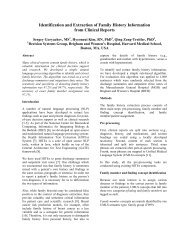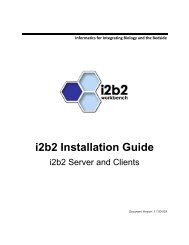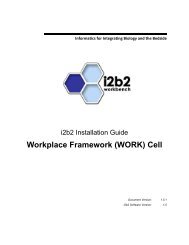Data Repository (CRC) Cell - i2b2
Data Repository (CRC) Cell - i2b2
Data Repository (CRC) Cell - i2b2
You also want an ePaper? Increase the reach of your titles
YUMPU automatically turns print PDFs into web optimized ePapers that Google loves.
1. OVERVIEW<br />
The Clinical Research Chart (<strong>CRC</strong>) repository cell is one of the core cells in the <strong>i2b2</strong><br />
Hive. The <strong>CRC</strong> cell is designed with several requirements. The main requirements are:<br />
1. It must be able to hold healthcare information from many different venues and<br />
allow it to be queried rapidly even if there are hundreds of millions of rows.<br />
2. It must be easily combined with other project repositories to form large unified<br />
repositories.<br />
3. Finally, it must allow objects to be stored that are present in the genomic data.<br />
Currently information in the <strong>CRC</strong> cell is related to clinical data and hence it’s also called<br />
Clinical Research Chart. For the remainder of this document, the terms <strong>CRC</strong> and <strong>Data</strong><br />
<strong>Repository</strong> <strong>Cell</strong> will be used interchangeably to refer to the same cell.<br />
The <strong>CRC</strong> is a data warehouse of patient’s phenotype and genotype information. It is<br />
supported by a powerful metadata management module (the Ontology <strong>Cell</strong>). Currently<br />
the <strong>CRC</strong> handles concepts such as diagnoses, procedures, medications, and lab tests,<br />
but the structure of the table gives enough flexibility to expand this to include virtually<br />
any kind of observation. The presence of both genotype and phenotype information<br />
makes this cell a powerful tool for researchers.<br />
All patient data present in the <strong>CRC</strong> is de-identified; the only exception is the patient<br />
notes from hospitals. These notes are stored in encrypted form, so only users enabled<br />
with an encryption key can view them.<br />
1.1 <strong>CRC</strong> Definitions, Acronyms and Abbreviations<br />
1.1.1 Patient <strong>Data</strong> Object (PDO):<br />
This object mirrors the star schema database model of the data mart. It holds patient<br />
information such as clinical observations, demographics and provider data.<br />
1.1.2 Setfinder Query:<br />
Setfinder queries are used to create a set of patients that satisfy a criteria presented<br />
in the query. The setfinder query is composed of query constraints, a list of panels<br />
and its items.<br />
1.1.3 Observation Fact:<br />
Any observation made on a patient can be stored as fact information in <strong>CRC</strong> data<br />
mart. The user can fetch the fact information via the PDO queries.<br />
Partners HealthCare Systems, Inc Page 5 of 22










